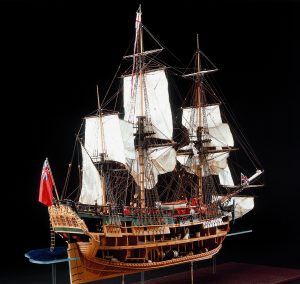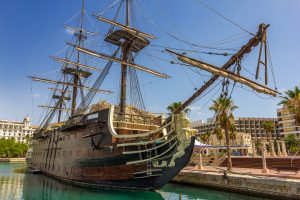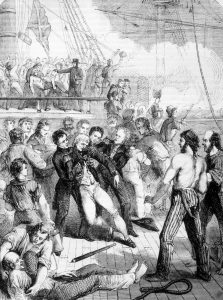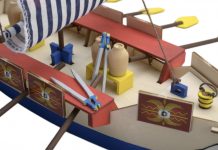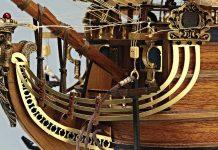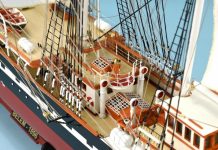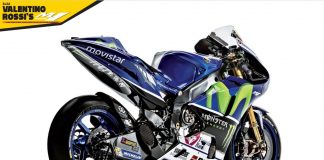Ships at the Battle of Trafalgar
The Battle of Trafalgar is known as the last of the great sea battles, and the ships at Battle of Trafalgar were the ultimate in naval combat. The Battle of Trafalgar ships were loaded with as many cannons as was reasonably possible, and the sheer resulting size and weight of the ships is extremely impressive. Here, we explore the different Battle of Trafalgar ships, look at how many fought for each side, how many British ships were lost, and we learn about the ship that brought the good news back to shore.
How many ships were in the Battle of Trafalgar?
Surprisingly, although the British fleet was victorious, they had fewer ships in the Battle of Trafalgar than their rivals; the British fleet consisted of 27 ships, whereas the French and Spanish mixed fleet reached a total of 33. The ships used in the Battle of Trafalgar were sailing vessels and were laden with heavy arms, which meant they moved very slowly. As a result, a good captain had to anticipate where each ship needed to be and plan carefully. In this case, the strategy employed by Admiral Nelson, who was known for his daring and risky battle tactics, worked extremely well.
What ships were involved in the Battle of Trafalgar?
Large battleships
Almost all the Battle of Trafalgar ships were two-decker and three-decker sailing warships. This meant they had either two or three decks completely dedicated to the loading and firing of guns, and so could hold between 64 and 135 guns.
Smaller ships
Smaller, more agile ships were essential for recognisance and relaying messages. At the Battle of Trafalgar, ships called frigates, which were one-deck battleships with just 36 guns, mainly held back during the fighting. They came in once the battle was won to rescue survivors and take prisoners. Smaller battleships, called brigs, and merchant and cargo ships, specifically a schooner and a cutter, were also present and had similar roles.
What was the most famous ship at the Battle of Trafalgar?
The most famous ship at the Battle of Trafalgar is, by far, HMS Victory. HMS Victory was an impressive first-rate ship-of-the-line, meaning it belonged to the category for the largest naval warships in the Royal Navy. HMS Victory was a three-decker and held the most guns among the British ships at the Battle of Trafalgar, carrying a total of a 104 between its three decks. Now the oldest commissioned warship in the world, it can be visited in Portsmouth, England, as a memorial ship.
What was the largest ship at the Battle of Trafalgar?
You may assume that the largest ship at the Battle of Trafalgar was Admiral Nelson’s famous flagship HMS Victory, but it was not. The Battle of Trafalgar ship with that title is the Spanish Santísima Trinidad.
Santísima Trinidad wasn’t only the largest ship at the Battle of Trafalgar, but also the largest and heaviest ship-of-the-line in the world at the time. It was heavily armed when first constructed as a 112-gun three-decker, but a fourth gun deck was later built, bringing the total to a tremendous 136 guns. This, however, had its disadvantages because the weight slowed the ship down. On the day of the Trafalgar battle, light winds meant it couldn’t be strategically manoeuvred, and Santísima Trinidad ended up surrendering and was eventually scuttled (intentionally sunk) by British sailors.
How many British ships were lost at the Battle of Trafalgar?
No British ships were lost at the Battle of Trafalgar. Even though the British had around 1,600 casualties, including Admiral Nelson himself, only French and Spanish ships were lost. A large number of their ships were captured by the British, and many were destroyed, including the Spanish four-decker Santísima Trinidad.
What was the name of the ship that brought news of the Battle of Trafalgar?
The name of the ship that brought news of the Battle of Trafalgar was HMS Pickle. Pickle was a topsail schooner, which was a small ship with square topsails and just 8 guns. Schooners were agile, but not fit for battle, so Pickle kept a distance during the fighting as one blow would have been enough to destroy it. Its role was one of recognisance, rescue, and delivering messages, and it was an honour for both its captain and crew to be chosen to relay the news of victory.
The 60 ships that fought in the Battle of Trafalgar were the ultimate in naval combat, and one of them can still be enjoyed today; the most famous Battle of Trafalgar ship, Nelson’s flagship HMS Victory, is stationed as a museum ship in Plymouth port. Having been restored to its former glory, it is living proof of how impressive these ships were.


